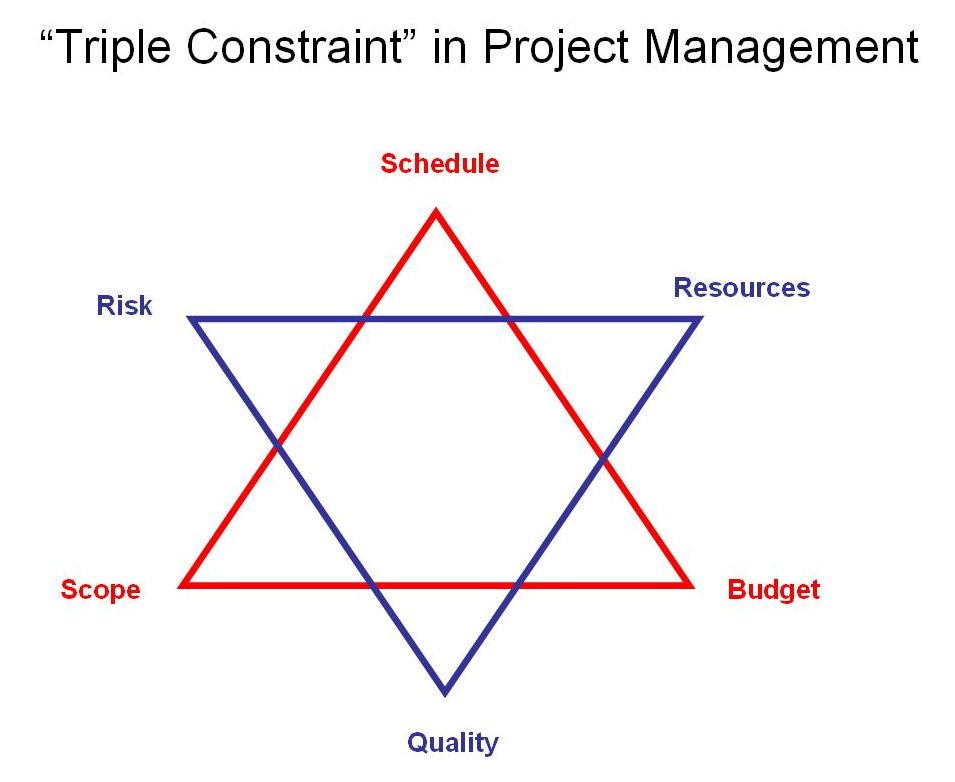Triple Constraints in Project Management: Quality, Cost & Schedule
The Triple Constraints
The challenge of every project is to make it work and be successful within the Triple Constraint; the Triple Constraint being quality (scope), cost (resources) and schedule (time). These three elements of a project are known to work in tandem with one another. Where one of these elements is restricted or extended, the other two elements will then also need to be either extended/increased in some way or restricted/reduced in some way. There is a balancing of the three elements that only when fully understood by the Project Manager, allows for the successful planning, resourcing and execution of a project. At the end of the day, these are the key elements of a successful project and these are the things that will determine whether or not you have successfully managed a project.
More on the Triple Constraint
Now, you may ask yourself, what is so important about the Triple Constraint and what does it affect in the scheme of things? Let’s look a little more closely at the three components that make up the Triple Constraint:
Scope/Quality
The scope of a project (often called the Scope of Work) is a clear, specific statement as to what has been agreed to be preformed/achieved in a particular project. In other words, the scope expressly lays out the functions, features, data, content, etc. that will be included in the project at hand. You could also say that the scope clearly expresses the desired final result of a project.
Resources/Cost
This second element of the Triple Constraint is known as either Resources or Cost. Resources always cost money so the two are interchangeable in many ways. When we talk about the cost of a project, we are talking about what needs to be applied or assigned to the project in terms of money and effort in order to make things happen. This can be resources like manpower/labor, it can be materials needed for the job, resources for risk management and assessment or any third party resources that might need to be secured.
Time/Schedule
Time, in project management, is analyzed down to its smallest detail. The amount of time required to complete each and every component of a project is analyzed. Once analysis has taken place, those components are broken down even further into the time required to do each task. Obviously from all of this we are able to estimate the duration of the project as well as what and how many/much resources need to be dedicated to that particular project.
Prioritizing the Triple Constraint
One of the first tasks a project manager of a brand new project is faced with is the prioritization of the Triple Constraint. This can only be done by communicating with the client. Whether the client understands project management or has ever heard of the Triple Constraint, in their mind, they already know what is most important to them. Your job, as project manager, is to find this out. This is usually done by asking them a series of very, well-worded questions. As you master the skill of balancing the Triple Constraint you will naturally begin to keep track of all aspects of project management and you will begin to understand what to look out for and at what stages of a project you should
Client Concerns and Priorities
Generally, when a client approaches you about a project, they are very clear about what is important to them. In some instances the priority is the bottom line. ‘I do not want to pay over x amount of dollars, make it happen’! Other times, a client has a launch date that they feel they can not miss under any circumstances. In these circumstances it is very clear that the primary way that they will judge whether a project is a success or failure will be based on whether or not you are able to meet the deadline.
Educating the Client
If your client does not have a good understanding of project management and its related issues, which is often the case, you will have the task of educating them, at least on a basic level. Clients often need to be made to realize that, if a project is to be completed at a certain level of quality, then a certain amount of time and money need also to be invested in the project. A project that has time restrictions will need to increase the resources assigned to it or have the quality or scope reduced. The well known Triple Constraint formula is Cost * Schedule = Quality.
The Right Balance
By understanding the Triple Constraint and the ramifications associated with adjusting any one of its components, you will be able to plan your projects better, analyze project risks and protect your company from the problems of unrealistic client expectations. You will also be properly equipped to balance out the triple constraint when any adjustment has been made to one or more of its elements. By mastering the Triple Constraint, in many ways you master the project itself.
Evolving with the PMBOK 4.0 Project Management Star
Obviously this model is just another model to help elaborate, evaluate and discuss all aspects of a project and it’s items. Not surprisingly, in PMBOK 4.0 the PMI came up with a suggestion of have six dimensions, with risk making it into the equation, with the “Project Management Star”.
